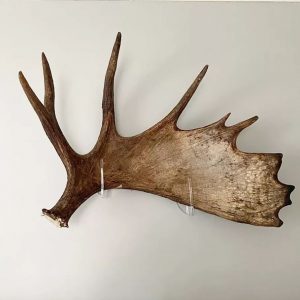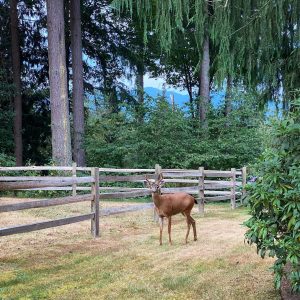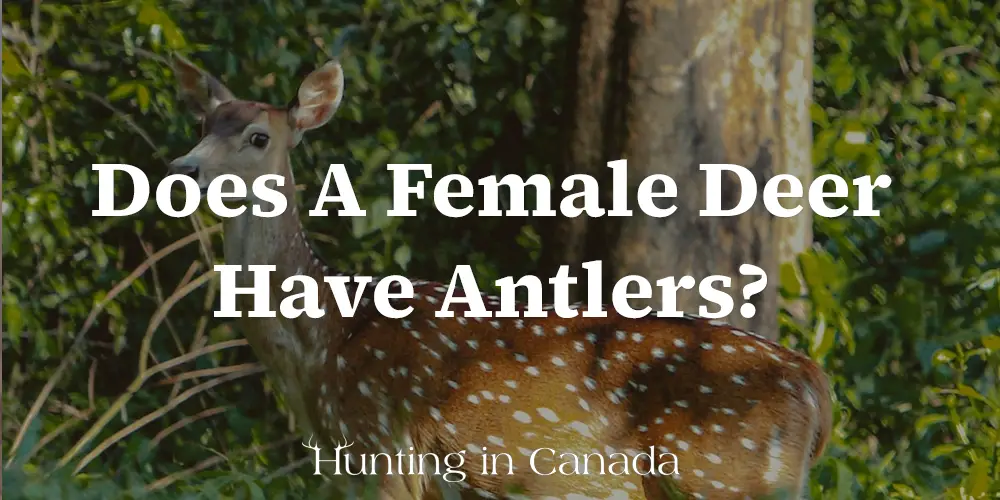Antlers are a kind of bone that protrudes from the forehead of some animals. Due to their rapid growth and deciduous nature, it got the interest of both hunters and wildlife enthusiasts.
The deer use their Antlers for different purposes, such as displaying their strength and dominance, defending themselves from predators, finding food, and keeping themselves cool in warmer temperatures.
In the deer world, there is a common belief that only deer bucks have antlers and does don’t. So have you ever wondered if there are female deer with antlers? Well, there are a lot of different species of deer. Every year, male deer of all species grow antlers of all kinds, but does a female deer have antlers as well?
In this article, you get to know which deer species have antlers, what they use them for and why they have them.

When Do Deer Grow Antlers?
When you look at newborn fawns and compare them with mature bucks with big antlers, you might be wondering, When do deer begin growing antlers? Well, the antlers’ growth of young male deer will start at about four or five months of age. But they are not what they seem.
In fact, they are not quite antlers but pedicles that are more similar to small hairy bumps. Those pedicles attach directly to the deer skull and act as the base of the antler. Once the deer bucks reach about a year old, the true antlers grow from those pedicles.

Why Do Deer Grow Antlers?
To Attract A Mate
Attracting a female deer for mating is one of the main reasons that male deer grow antlers. When their antlers are growing during mating season, every buck will try to be the most dominant male and display their antlers.
Also, the antlers can act as a weapon. The bucks will use them to fight each other to compete for a female mate or establish dominance.
In order to show their dominance, male deer will also rub their antlers against the trees. Bucks with the largest antlers are more likely to obtain a female mate due to their competitiveness.
Relaxation
During the summer, deer use their antlers to help them cool down and relax. They can be used to make depressions in the dirt or mud, so the deer can lie in or roll in to relax, cool down, and keep insects off.
Finding Food
Deer are herbivores that can eat fruits, nuts, acorns and more. But they do not eat meat. They will use their antlers to knock down fruit from trees, or they can knock down acorns and nuts when available.
Defence Against Predators
Since antlers can cause serious injuries, some researchers have suggested that the deer may use them as a defence tool against predators. Although this may be a true theory, it would mean that the bucks will be defenceless when their antlers are still growing and when their antlers have shed. And the does will always be defenceless ( unless they have antlers)
Does A Female Deer Have Antlers?
Reindeer are unique among other deer species as the female deer have antlers as well. The reason for this is that it is more difficult for reindeer to find food while living in cold regions. So they have to compete more vigorously for food. Here the antlers will be helpful while digging the snow in order to expose the food source.
The female reindeer with especially large antlers is able to intimidate other females with smaller antlers and keep them away from their valuable food source.
reindeers are just like any other deer with antlers; their antlers are shed each and every year. The antlers of male deer are shed after the rut (later periods of autumn). In contrast, the antlers of the Female reindeer will remain until the spring as they have to keep access to food while they are pregnant, which happens in winter. So their antlers are important to keep digging and foraging for food.
The antlers of the male reindeer are significantly bigger than their female counterparts. Females tend to grow 20-inch antlers, while males can have larger antlers with a length up to 50 inches after numerous seasons of shedding. The length of time that the two can keep their antlers is another thing that can distinguish between them.
Why Does A Female Deer Have Antlers?
Testosterone is an important hormone for antlers’ growth; male deer produce it, but sometimes does produce it as well. The imbalance in the hormones can cause the female to produce higher testosterone levels. That is why on a very rare occasion, the female deer can have antlers.
There are also deer that have a set of antlers to grow. This is due to rare genetic defects. Those defects differ from the seasonable deer antlers as they do not shed, but they are permanent antlers. Plus, it grows from the skull plate inside, not from the pedicels.
Whitetail Deer
What about Whitetail Deer? Does a female deer have antlers?
The whitetail does do not have antlers as a rule. But on very rare occasions, there is a possibility for a female whitetail deer to have some sort of antlers. They might have antlers with these two circumstances.
In the first type, the doe may always have antlers with a velvet cover. This type of antlered doe can become pregnant as they will often have a fully complete female reproductive system.
While the second type, which is sometimes called pseudo-hermaphrodites, is designated as between the two sexes. They have polished antlers, like other deer antlers, after they have shed their velvet. These types of deer have female reproductive organs externally and male ones internally.
Whitetail doe with antlers has exceedingly high testosterone levels. But as we said earlier, the whitetail doe will only have antlers on very rare occasions. According to the scientist, it may be about 1 in 10,000, so it is very rare to happen.
Factors Affecting Antler Size
It is not easy to understand the growth in deer, but it is thought that nutrition, genetic factors, age, and hormone levels have an effect on the antler size.
Also, the antler’s size will differ from one deer species to another. For instance, the antlers of a mule deer (Odocoileus hemionus) can be around 12 in (30 cm) long, while those of a white-tailed deer (Odocoileus virginianus) can reach up to 6 ft (1.8 m) long.
The antler’s function differs among deer species as well. Some of them may use their antlers more for defence against predators such as the reindeer. While in other species, such as the whitetail deer, the use of their antlers is primarily for the competition between bucks. They use this way to display dominance and strength over other male deer.

Are Antlers The Same As Horns?
Antlers have always been valued and sought after by hunters. It is one of the most special characteristics of the Cervidae family of deer, including mule deer, moose, caribou, elk, and white-tailed deer.
Some mammals, such as sheep and goats, have horns. But the deer antlers and horns are totally different. Antlers are constructed of bone, and both the bone of the antlers and the other bones of the animal body are chemically identical, although there is a sheath of keratin protecting them (the same material as fingernails and hair)
The major difference between horns and antlers is that the former is permanent while the latter is seasonal. Antlers can grow very fast; their growth can reach up to an inch a day. The velvet material is the primary reason for this fast growth. It is a dense coating that lines the external part of the growing antler. This material is composed of dense blood vessels that supply the antlers with nutrients and help shield them against infection risk.
Reasons For Deformed Antlers
There are three reasons that are most common for deformed antlers. Those reasons are poor nutrition, injury, or genetic defects.
The number one reason for deformed antlers is injury. Deer can grow deformed antlers if they are injured during the antler growing process. This could happen, for instance, when being hit by a car, fighting other deer, or caught in something.
If the antlers of deer are damaged while they are growing, it can cause them to grow abnormally, and there is no way of fixing this once the damage has been done.
The second common reason that can cause deformed antlers is poor nutrition. If the deer diet does not involve enough of the right nutrients, the antler’s growth can be affected. Some of those nutrients are phosphorus and calcium. The antlers will not grow properly without these important nutrients.
The third most common reason for deformed antlers is genetic defects. This means that it can be anything from a deformity in the antlers themselves or even problems with how they grow, passed down through either parent’s lineage to the offspring. If any one of the parents has a genetic defect, then the offspring will probably have it as well.
While there are a lot of reasons that can cause deformed antlers, those three are the most common ones. so If you notice a deer with deformed antlers, this is probably because of one of these three reasons.

